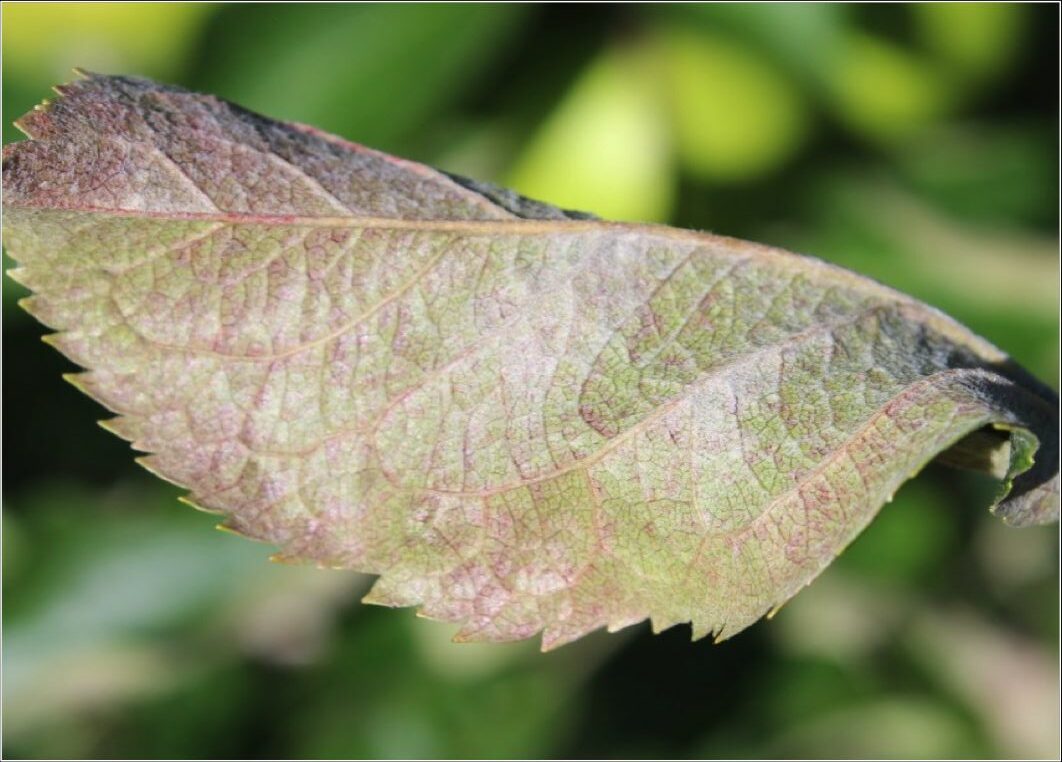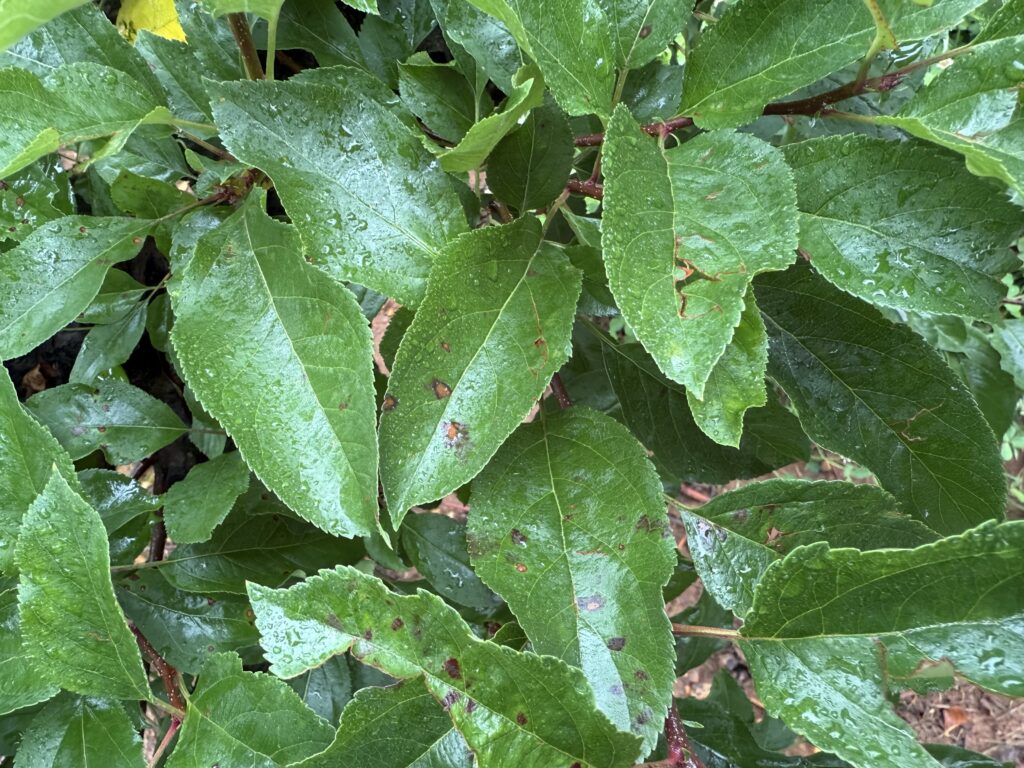Apple Disease Update: Week of May 25, 2025
go.ncsu.edu/readext?1074532
en Español / em Português
El inglés es el idioma de control de esta página. En la medida en que haya algún conflicto entre la traducción al inglés y la traducción, el inglés prevalece.
Al hacer clic en el enlace de traducción se activa un servicio de traducción gratuito para convertir la página al español. Al igual que con cualquier traducción por Internet, la conversión no es sensible al contexto y puede que no traduzca el texto en su significado original. NC State Extension no garantiza la exactitud del texto traducido. Por favor, tenga en cuenta que algunas aplicaciones y/o servicios pueden no funcionar como se espera cuando se traducen.
Português
Inglês é o idioma de controle desta página. Na medida que haja algum conflito entre o texto original em Inglês e a tradução, o Inglês prevalece.
Ao clicar no link de tradução, um serviço gratuito de tradução será ativado para converter a página para o Português. Como em qualquer tradução pela internet, a conversão não é sensivel ao contexto e pode não ocorrer a tradução para o significado orginal. O serviço de Extensão da Carolina do Norte (NC State Extension) não garante a exatidão do texto traduzido. Por favor, observe que algumas funções ou serviços podem não funcionar como esperado após a tradução.
English
English is the controlling language of this page. To the extent there is any conflict between the English text and the translation, English controls.
Clicking on the translation link activates a free translation service to convert the page to Spanish. As with any Internet translation, the conversion is not context-sensitive and may not translate the text to its original meaning. NC State Extension does not guarantee the accuracy of the translated text. Please note that some applications and/or services may not function as expected when translated.
Collapse ▲Yesterday as I was “enjoying” the gloomy memorial day weather, I received a phone call from Gene Klimstra that had observed Glomerella leaf spot in some orchards in Polk County. While we were slightly surprised by the early onset of symptoms, I went back through the literature to confirm that Colletotrichum can cause infection at temperatures as low as 57 F, particularly under extended leaf wetness. As I was preparing to write this post this morning, I went out to scout my “Glomerella Gala” research block at the MHCREC and was “un”-pleasantly surprised to see GLS symptoms on the lower foliage of control trees (not sprayed-see above photo).
While it’s been cool out, given 24-32 hrs of consecutive leaf wetness, infection by Colletotrichum species that cause GLS can occur at temperatures slightly above 57 F, and a minimum of 16 hours of leaf wetting are needed at at temperature of 60.8 F. Using this logic, I went back through hourly leaf wetness data and temperature data for the Klimstra NEWA weather station for the month of May 2025. I can identify 3, maybe 4 infection periods for this month, but both were pretty marginal given the low temperatures during the time that leaves were wet and one of these is still occurring from yesterday (May 26). A few things that I can discern from this:
- Perhaps (likely) there was a lot of carry over inoculum from last year-particularly due to the aftermath of Helene. Remember that the pathogen can overwinter on infected leaves on the ground, mummified fruit/infected fruit in the canopy or underneath the tree, in cankers, and in buds. By far though, the majority of inoculum for leaves is coming from last year’s orchard litter.
- The logic for the models is not perfect. There are several Colletotrichum species that can cause GLS and bitter rot. Most of the infection conditions for GLS are based on Colletotrichum gloeosporioides. While the species causing GLS are very closely related to this species, they are not the exact species. This highlights the need for further research. Particularly since the species causing GLS changed last year in some orchards (particularly those with FRAC 11 (strobilurin) resistance.
Last week I mentioned I’d be discussing fungicide resistance, but given the length of this post, I plan to punt that topic to next week. If you have GLS symptoms in your orchard please reach out to myself, your consultant, or your extension agent and we will visit you to survey for species and fungicide resistance. As for now consider the following for GLS this week:
1. There really isn’t a way to “burn out” GLS and bitter rot lesions. If you’ve already applied two applications of Merivon or you have resistance to the strobilurins (FRAC 11), I’d consider an application of Aprovia (7 floz/A) + Captan 80WDG (2.5 lb/A) this week.
2. From a field trial last year, I don’t think Captan is redistributing as much as I’d expected. This is particularly the case if we don’t get any rain. This is still a period of rapid shoot expansion and even on a 7 to 10 day application interval, new shoots and emerging leaves may not be protected. Although this is just a feeling (that needs to be explored through research), one would think that slowing or stopping further terminal growth (particularly on larger rootstocks) would help this issue. For those who haven’t applied prohexadione calcium (Kudos) this year and if you’ve had particularly problematic mature blocks on larger rootstocks, you may want to consider applying two applications of Kudos (12 oz/100 gal) about 14 days apart to slow growth. Another option could be a maintenance schedule of 3-6 oz/100 gal on 10-14 day intervals. Regardless of this helps keeps all foliage protected between spray intervals, reducing vigor will help with leaf drying and spray penetration. Also avoid applying calcium during these sprays.
 In addition, I’ve also had reports this week about powdery mildew being fairly severe in some orchards and on some cultivars. Sulfur such as Microthiol Disperss is a fine option on cooler days for control and to help burn it out. However, I’d be careful applying it when temps are between 80-85 F and would refrain from applying sulfur when temps exceed 85 F. We are already prone to russet on fruit in the mountains, and sulfur could exacerbate the issue. Other alternatives include DMIs like Rally, Procure and Topguard. However, some growers are reporting issues with mildew following DMI applications which leads to me to believe there could be some resistance issues springing up. Gatten or Torino are alternatives with unique FRAC groups but I’m not sure on pricing. Keep in mind, these will be specific for powdery mildew. Also, recall that Captan and Manzate do not have strong efficacy against this disease.
In addition, I’ve also had reports this week about powdery mildew being fairly severe in some orchards and on some cultivars. Sulfur such as Microthiol Disperss is a fine option on cooler days for control and to help burn it out. However, I’d be careful applying it when temps are between 80-85 F and would refrain from applying sulfur when temps exceed 85 F. We are already prone to russet on fruit in the mountains, and sulfur could exacerbate the issue. Other alternatives include DMIs like Rally, Procure and Topguard. However, some growers are reporting issues with mildew following DMI applications which leads to me to believe there could be some resistance issues springing up. Gatten or Torino are alternatives with unique FRAC groups but I’m not sure on pricing. Keep in mind, these will be specific for powdery mildew. Also, recall that Captan and Manzate do not have strong efficacy against this disease.
Lastly, please note our Twilight orchard meeting at Trey Enloe’s this coming Thursday May 29 @ 5:30 p.m. Hope to see y’all there!



